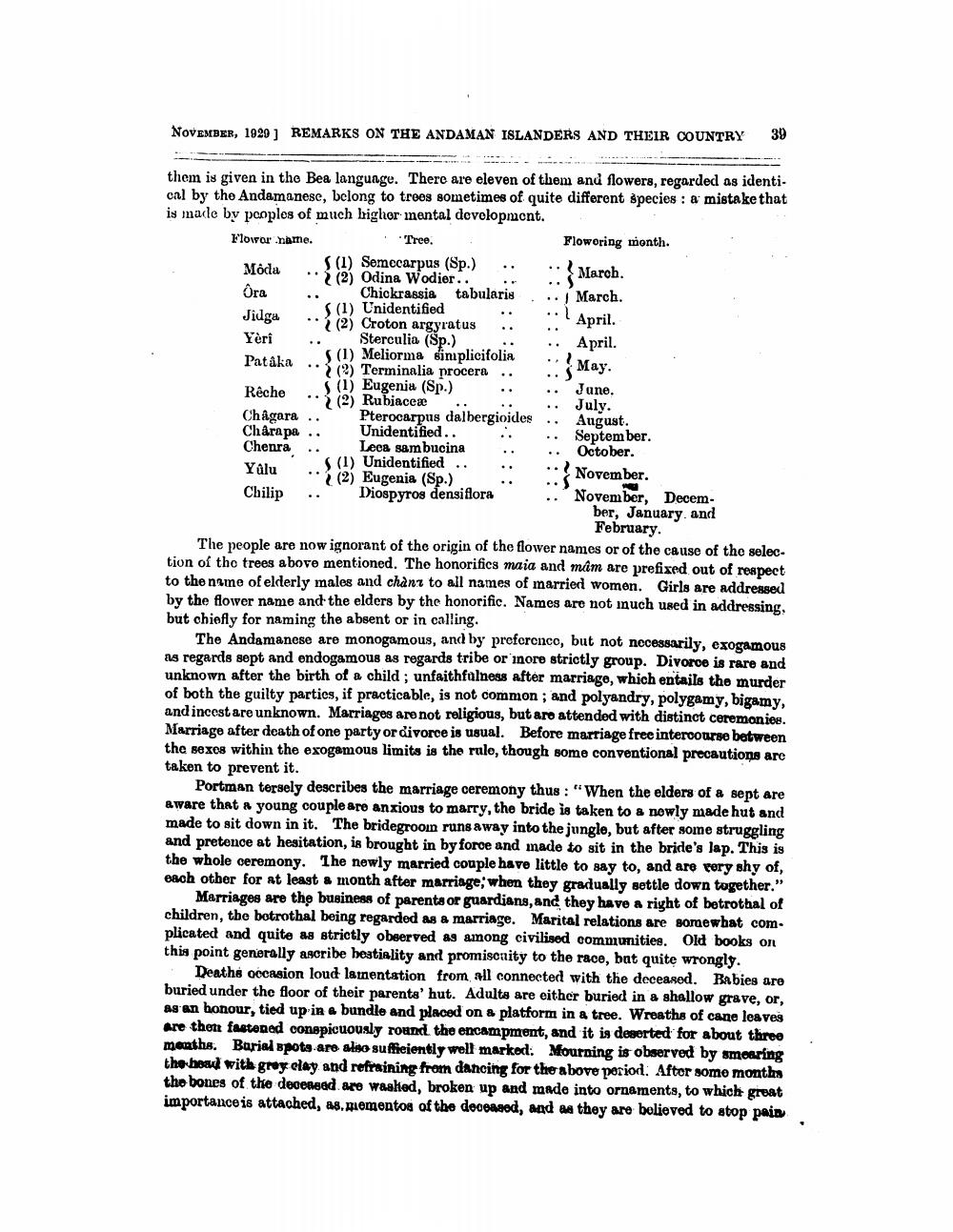________________
NOVEMBER, 1920] REMARKS ON THE ANDAMAN ISLANDERS AND THEIR COUNTRY
39
..May.
Rêche
(2) Rubiaceae
Julhergioides
November.
them is given in the Bea language. There are eleven of them and flowers, regarded as identical by the Andamanese, belong to trees sometimes of quite different species : a mistake that is malo by peoples of much higher inental dovolopment. Flowor name.
Tree.
Floworing month. (1) Semecarpus (Sp.) Móda
.. .. ) March. (2) Odina Wodier... Ora
Chickrassia tabularis ... March.
(1) Unidentified Jidga (2) Croton argyratus
April.
.. .. Yeri Sterculia (Sp.)
.. April. (1) Meliorma simplicifolia Pataka ..
(9) Terminalia procera .. (1) Eugenia (Sp.) ..
.. June.
.. July. Chagara Pterocarpus dalbergioides .. August. Chåra pa Unidentified..
September Chenra .. Leca sambucina
.. October. (1) Unidentified .. Yalu
.. ..
(2) Eugenia (Sp.) Chilip .. Diospyros densiflora .. November, Decem
ber, January and
February. The people are now ignorant of the origin of the flower names or of the cause of the selection of the trees above mentioned. The honorifics maia and mim are prefixed out of respect to the name of elderly males and chant to all names of married women. Girls are addressed by the flower name and the elders by the honorific. Names are not inuch used in addressing, but chiefly for naming the absent or in calling.
The Andamanese are monogamous, and by preference, but not necessarily, exogamous as regards sept and endogamous as regards tribe or inore strictly group. Divorce is rare and unknown after the birth of a child ; unfaithfalness after marriage, which entails the murder of both the guilty partics, if practicable, is not common; and polyandry, polygamy, bigamy, and incest are unknown. Marriages are not religious, but are attended with distinct ceremonies. Marriage after death of one party or divorce is usual. Before marriage free intercourse between the sexes within the exogamous limits is the rule, though some conventional precautions are taken to prevent it.
Portman tersely describes the marriage ceremony thus : "When the elders of a sept are aware that a young couple are anxious to marry, the bride is taken to a newly made hut and made to sit down in it. The bridegrooin runs away into the jungle, but after some struggling and pretence at hesitation, is brought in by force and made to sit in the bride's lap. This is the whole ceremony. The newly married couple have little to say to, and are very shy of, each other for at least a month after marriage, when they gradually settle down together."
Marriages are the business of parents or guardians, and they have a right of betrothal of children, the botrothal being regarded as a marriage. Marital relations are somewhat com. plicated and quite as strictly observed as among civilised communities. Old books on this point generally ascribe hestiality and promiscnity to the race, bat quite wrongly.
Deaths oocasion loud lamentation from all connected with the deceased. Babies are buried under the floor of their parents' hut. Adults are either buried in a shallow grave, or, as an honour, tied up in a bundle and placed on a platform in a tree. Wreaths of cane loaves are then fastened conspicuously round the encampment, and it is deserted for about three months. Barial spots are also sufficiently well markod: Mourning is observed by smoaring the-board with gray clay and refraining from dancing for the above poriod. After some months the bones of the decenead are Wasked, broken up and made into ornaments, to which great importance is attached, as.plementos of the deceased, and as they are believed to stop paid




